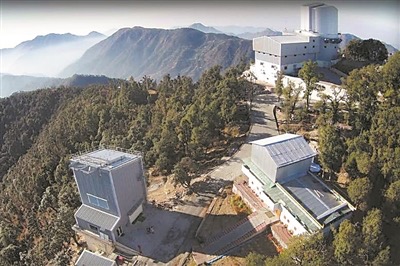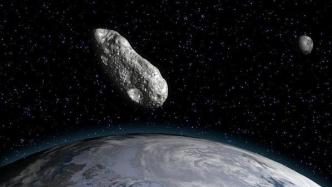
According to a recent report on the website of the British "New Scientist" magazine, the "International Liquid Mirror Telescope" (ILMT) with a diameter of 4 meters on the Himalayas has opened its "eyes" and looked into the depths of the universe. Instead of a solid mirror, the disk focuses the light for observation.
Compared with traditional telescopes, liquid mirror telescopes are much cheaper to build and have other unique advantages. If ILMT is successful, a larger liquid mirror telescope may be placed on the moon in the future to help see the "look" of the first star in the universe.

A liquid mirror telescope with a diameter of 4 meters. Image source: British "New Scientist" magazine website
The road is obstructed and long, and the journey is approaching
The basic concept of a liquid mirror telescope is pretty simple: If you stir a liquid, its surface takes the shape of a plate, which, it turns out, is perfect for focusing light.
The concept of a liquid mirror telescope dates back to the 17th century and Isaac Newton, but no attempt was made to build such a telescope until the late 19th century. In the early 20th century, American physicist Robert Wood made a prototype of a small liquid mirror telescope with a diameter of 5 cm. But Wood encountered many difficulties in the manufacturing process: ripples were produced in the mercury, and it was difficult to create a plate that allowed the metal to rotate at a constant speed.
In 1982, Ermano Bora of Laval University in Canada found a solution. In response to the ripples that plagued Wood, he suggested dampening the vibrations by pumping a thin layer of air between the basin containing the mercury and the motor turning it. He also suggested pouring liquid resin on the surface of the disc, allowing it to dry into the proper shape, and then pouring a reflective liquid over it as a coating, reducing the amount of mercury needed.
After a series of improvements, Bora and others built a liquid mirror telescope with a diameter of 2.7 meters near Vancouver, Canada in 1994. Paul Hickson of the University of British Columbia in Canada, in cooperation with NASA, built a 3-meter liquid mirror telescope in New Mexico to observe space debris. In the early 2000s, the University of British Columbia built the experimental 6-meter Large Zenith Telescope on a hilltop outside Vancouver. These projects confirmed what many astronomers thought: Liquid-mirror telescopes are much cheaper to build than conventional telescopes.

In a liquid mirror telescope, mercury reflects light. Image source: British "New Scientist" magazine website
High quality and low price with many advantages
The researchers say that liquid mirrors cost only about 1% of glass mirrors, making them ideal for use in large telescopes.
ILMT is worth 2 million US dollars and is jointly built by Belgium, Canada and India. Not far from ILMT is another 3.6-meter, steerable Devasthal Optical Telescope, built at the same time by the same Belgian company, but at a price of $18 million.
In addition to high quality and low price, LIMT is also very focused. Unlike ordinary telescopes that can point to different places, the liquid mirror telescope can only look directly at the sky above the head, said Jean Sulder, the ILMT project leader and an astronomer at the University of Liege in Belgium. This was initially considered a serious disadvantage, since there was no way to observe specific objects. But Hickson said: "By repeatedly looking at the same part of the sky, you get time-lapse images, which is a good way to detect fast-appearing objects-such as supernovae and fly-by asteroids. And, for telescopes, Say, the best image quality is taken right above it because that's where the transparency is the best."
Another advantage of ILMT is its location: it is in close proximity to India's largest optical telescope, and if ILMT finds something interesting, scientists can follow it up with other instruments.
Given ILMT's many advantages, if it proves successful, scientists may be able to build new liquid-mirror telescopes elsewhere in the world. For example, the University of British Columbia had planned to build an 8-meter-diameter liquid-mirror telescope on a Chilean mountaintop, but the project was shelved due to lack of funds.
NASA is running experiments to see if liquids can be used to make other parts of space telescopes. In the absence of gravity, any drop of liquid would end up in a perfectly spherical shape that could be used to make a lens. Liquid lenses have proven to be as good or better than glass lenses when tested in simulated microgravity environments, but are much easier and faster to make.
The first star or real body
The ultimate dream of Anna Sauer, an astrophysicist at the University of Texas at Austin, is to build a giant liquid mirror telescope on the surface of the moon to observe the first stars in the universe.
Sauer and his colleagues are investigating the feasibility of building a 100-meter-diameter liquid-mirror telescope to observe the elusive population-III stars, the earliest stars in the universe. Scientists believe that these stars exist in smaller clusters and emit light so faintly that even the James Webb Space Telescope is unlikely to see them.
Liquid mirror telescopes on the moon would not be made of mercury, though, because the metal is too dense to work properly on the lunar surface. One alternative is an ionic liquid (a salt in liquid form). Whatever the material, the instrument would be housed in a crater near the moon's poles and send data to satellites in lunar orbit.
(Originally titled "The World's Largest Liquid Mirror Telescope Begins to Look Up at the Starry Sky")
